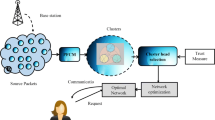Abstract
The role of wireless sensor networks is ubiquitous in the present era. The dependency of wireless sensor networks is inevitable for small scale to large scale applications due to its compact, reliable, and efficient processing capabilities. However, wireless sensor network has its few limitations. Since the network is created by deploying sensor nodes and it requires efficient energy management procedures. Localization of nodes is an important process that should be considered in wireless sensor networks which directly relates the energy management. To reduce the node localization issues in wireless sensor networks, this research work proposed a hybrid optimization model using Particle Swarm Optimization and Grey Wolf Optimization as a combined approach. The proposed model effectively handles the node localization issues. To reduce the data processing and storage issues in wireless sensor networks, Cloud module is incorporated in the proposed model which improves the energy management features. Similarly, to transfer the data from node to cloud, hybrid optimization model shortest path discovery process is utilized. This combined approach reduces the packet loss, avoids route failures, improves network reliability, and lifetime compared to conventional models such as ant colony optimization.







Similar content being viewed by others
References
Mostafaei, H., Chowdhury, M. U., & Obaidat, M. S. (2018). “Border surveillance with WSN systems in a distributed manner. IEEE Systems Journal, 12(4), 3703–3712.
Chanak, P., & Banerjee, I. (2020). Congestion free routing mechanism for IoT-enabled wireless sensor networks for smart healthcare applications. IEEE Transactions on Consumer Electronics, 66(3), 223–232.
Umamaheswari, S. (2020). Performance analysis of wireless sensor networks assisted by on-demand-based cloud infrastructure. International Journal of Communication Systems, 33(7), 1–11.
Chuan, X., Xiong, Z., Zhao, G., & Shui, Yu. (2019). An energy-efficient region source routing protocol for lifetime maximization in WSN. IEEE Access, 7, 135277–135289.
Ali, I., Ahmedy, I., Gani, A., Talha, M., Raza, M. A., & Anisi, M. H. (2020). Data collection in sensor-cloud: A systematic literature review. IEEE Access, 8, 184664–184687.
Umamaheswari, S. (2019). Capsule network-based data pruning in wireless sensor networks. International Journal of Communication Systems, 33(5), 1–12.
Ahmed, A., Ashraf, U., Tunio, F., Bakar, K. A., & Saeed AL-Zahrani, M. (2018). Stealth jamming attack in WSNs: Effects and countermeasure. IEEE Sensors Journal, 18(17), 7106–7113.
Nurellari, E., McLernon, D., & Ghogho, M. (2018). A secure optimum distributed detection scheme in under-attack wireless sensor networks. IEEE Transactions on Signal and Information Processing over Networks, 4(2), 325–337.
Xie, H., Yan, Z., Yao, Z., & Atiquzzaman, M. (2019). Data collection for security measurement in wireless sensor networks: A survey. IEEE Internet of Things Journal, 6(2), 2205–2224.
Aliady, W. A., & Al-Ahmadi, S. A. (2019). Energy preserving secure measure against wormhole attack in wireless sensor networks. IEEE Access, 7, 84132–84141.
Han, G., Yang, X., Liu, L., Zhang, W., & Guizani, M. (2020). A disaster management-oriented path planning for mobile anchor node-based localization in wireless sensor networks. IEEE Transactions on Emerging Topics in Computing, 8(1), 115–125.
Li, Y., Wang, Y., Wenbin, Yu., & Guan, X. (2019). Multiple autonomous underwater vehicle cooperative localization in anchor-free environments. IEEE Journal of Oceanic Engineering, 44(4), 895–911.
Yuan, W., Nan, W., Etzlinger, B., Li, Y., Yan, C., & Hanzo, L. (2019). Expectation–maximization-based passive localization relying on asynchronous receivers: Centralized versus distributed implementations. IEEE Transactions on Communications, 67(1), 668–681.
Wang, B., & Tian, Y.-P. (2019). Distributed network localization: Accurate estimation with noisy measurement and communication information. IEEE Transactions on Signal Processing, 66(22), 5927–5940.
Naureen, A., Zhang, N., Furber, S., & Shi, Q. (2020). A GPS-less localization and mobility modelling (LMM) system for wildlife tracking. IEEE Access, 8, 102709–102732.
Bianchi, V., Ciampolini, P., & De Munari, I. (2019). RSSI-based indoor localization and identification for ZigBee wireless sensor networks in smart homes. IEEE Transactions on Instrumentation and Measurement, 68(2), 566–575.
Lin, Y., Tao, H., Ya, T., & Liu, T. (2019). A node self-localization algorithm with a mobile anchor node in underwater acoustic sensor networks. IEEE Access, 7, 43773–43780.
Shi, X., Tong, F., Zhang, W.-A., & Li, Yu. (2020). Resilient privacy-preserving distributed localization against dishonest nodes in internet of things. IEEE Internet of Things Journal, 7(9), 9214–9223.
Shen, S., Yang, B., Qian, K., Yumei She, W., & Wang, W. (2019). On Improved DV-hop localization algorithm for accurate node localization in wireless sensor networks. Chinese Journal of Electronics, 28(3), 658–666.
Cao, Y., & Wang, Z. (2019). Improved DV-hop localization algorithm based on dynamic anchor node set for wireless sensor networks. IEEE Access, 7, 124876–124890.
Phoemphon, S., So-In, C., & Leelathakul, N. (2019). Optimized hop angle relativity for DV-hop localization in wireless sensor networks. IEEE Access, 6, 78149–78172.
Ke, M., Zhao, G., Tian, S., Wang, C., & Liu, Y. (2019). Optimal power allocation for anchor nodes in jammed wireless localization systems. IEEE Wireless Communications Letters, 8(4), 1150–1153.
Wang, L., Er, M. J., & Zhang, S. (2020). A kernel extreme learning machines algorithm for node localization in wireless sensor networks. IEEE Communications Letters, 24(7), 1433–1436.
Sahota, H., & Kumar, R. (2018). Maximum-likelihood sensor node localization using received signal strength in multimedia with multipath characteristics. IEEE Systems Journal, 12(1), 506–515.
Naseri, H., & Koivunen, V. (2019). A Bayesian algorithm for distributed network localization using distance and direction data. IEEE Transactions on Signal and Information Processing over Networks, 5(2), 290–304.
Singh, P., & Mittal, N. (2020). Efficient localisation approach for WSNs using hybrid DA–FA algorithm. IET Communications, 14(12), 1975–1991.
Author information
Authors and Affiliations
Corresponding author
Additional information
Publisher's Note
Springer Nature remains neutral with regard to jurisdictional claims in published maps and institutional affiliations.
Rights and permissions
About this article
Cite this article
Umamaheswari, S. Hybrid Optimization Model for Energy Efficient Cloud Assisted Wireless Sensor Network. Wireless Pers Commun 118, 873–885 (2021). https://doi.org/10.1007/s11277-020-08048-w
Accepted:
Published:
Issue Date:
DOI: https://doi.org/10.1007/s11277-020-08048-w




